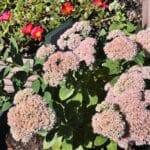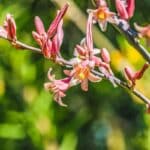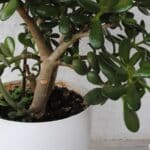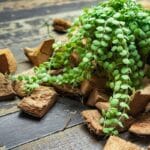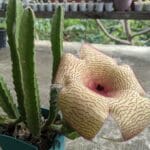Dischidia plants are exotic and easy-to-grow houseplants. It is a member of the milkweed family (Apocynaceae) and is closely related to plants of the genus Hoya, which is also well-known for its brilliant, occasionally aromatic, and frequently waxy blooms.
Most varieties are trailing which means they grow long stems that can climb and hang about. This characteristic makes larger varieties perfect for hanging containers where their stems and foliage spill out over the rim. Smaller varieties do well in countertop containers and terrariums.
These are epiphytic plants – plants that grow on trees or on the surfaces of other plants or objects like fallen logs and rocks. They receive their water and food from rainfall and from debris collecting around their roots. They are native to more tropical locations, and thus do well in warmer and more humid growing conditions.
Dischidias are resilient plants. They can tolerate droughts, and do not require excessive watering. And they can grow and tolerate a variety of different light conditions. Both of these qualities make them ideal for beginner gardeners and plant parents.
If you are curious about dischidia plants and what types of species are available to grow, keep on reading. Below you will find some of our favorite varieties.
Here are some of the most gorgeous kinds of Dischidia plants you can grow.
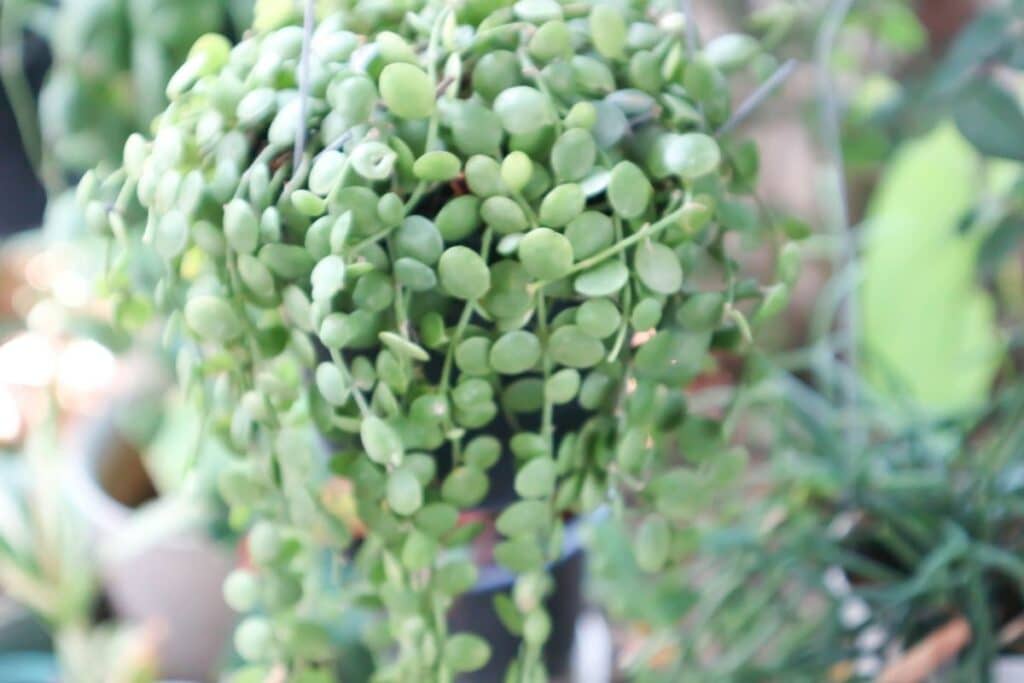
1. Kangaroo Pocket (D. vidalii)
The Kangaroo Pocket Dischidia is also known as the Thruppence Ravioli Plant and the Bladder Vine. These rather interesting names come from the plant’s unique foliage. Some of the leaves on this plant have evolved to form a purse or pouch-like enclosure. These leaves provide shelter to insects like ants. In exchange, the ants help fertilize the plant by their excrement.
The other leaves of this plant are small, thick, and oval-shaped. When it blooms, the flowers develop with a beautiful magenta color, and are arranged in clusters called umbels.
This plant grows best on a woody substrate. When it needs watering, the wood will be dry to the touch. You can simply submerge the container or soak it until the wood becomes moist again. If it needs extra humidity, you can mist the plant, or grow it in a humidifying tray with water and pebbles.
2. Million Hearts (D. ruscifolia)
The Million Hearts species is one of the most adorable and easy to grow epiphytic houseplants. Besides its endearing heart-shaped leaves, it is known for its low maintenance requirements. This Dischidia is easy to please and blossoms frequently. The flowers are tiny, white and actually provide a pleasant subtle fragrance.
The recommended growing substrate for this variety of epiphyte is a woody orchid potting mix, or coco husks. These types of substrate provide adequate structure for the roots, remain well ventilated and are easy to maintain. What’s interesting about this variety of dischidia is that when it recipes direct sunlight, the leaves are known to develop a reddish hue. Just be careful not to expose them to too much direct sunlight, as the delicate foliage may end up burning.
3. Watermelon Dischidia (D. ovata)
Dischidia ovata, or the Watermelon Dischidia, gets its name from its unique foliage. As it grows, the leaves of this plant eventually develop white stripes that zig and zag across the surface of the green leaves, resembling a watermelon. The flowers of this species are green and yellow with purple accents.
The Watermelon Dischidia does best in a location that gets bright but indirect sunlight. The perfect scenario would be behind a curtain of some sort in a south-facing window. But a window facing any other direction (besides north) should do the trick. If the plant does not get enough sunlight, the stems will become more ‘leggy’, and the leaves will grow farther apart. If the plant gets too much sun on the other hand, its leaves will begin to turn red.
4. String of Nickels (Dischidia nummularia)
The String of Nickels is an epiphytic dischidia plant that is native to countries in Asia like India, China, Indonesia, and Thailand. In the wild, this plant is most commonly found growing high above the ground on tree branches. For that reason, as a houseplant, the String of Nickels is frequently grown in hanging baskets.
Because this plant is used to growing on a woody surface, we recommend a chunky and woody growing substrate. Most store bought orchid mixes will do the trick, but we prefer coco husks. To retain extra moisture, you may also try adding sphagnum moss to the substrate. If the String of Nickels does not get enough water, its growth will be stunted, and its beautiful foliage will not be able to spill over the rim of its container and dangle elegantly.
5. Silver Star (Dischidia spp.)
The Silver Star Dischidia is a beautiful variety that is best for hanging containers. Its stems can grow multiple feet long, and boast green leaves with silver-ish accents around the fringes. When the leaves are arranged just right, they resemble little silver stars.
When it comes to watering, this variety of dischidia is relatively drought-tolerant. You can allow the growing substrate to dry out between waterings in order to avoid overwatering and root rot. It prefers bright, indirect sunlight and should not be placed directly in the sun.
6. The Shingle Plant (D. platyphylla)
This species of Dischidia receives its name from its odd growing habits. As the plant matures, the leaves begin to lay flat against the growing surface. They begin to overlap one another, and start to resemble the shingles on a roof. If you want to grow this type of Dischidia and get the full effect, we recommend mounting the plant onto a wooden plank or some sort of other flat surface.
The Shingle plant enjoys shade and partial shade. Ideally, the plant is grown in a warm environment that gets no colder than 50 degrees, and no hotter than 90 degrees fahrenheit. It will only grow to be a few inches tall, but its stems can grow to be multiple feet long. Avoid over watering this dischidia. To do so, allow it to dry out in between waterings.
7. Ant Plant (D. rafflesiana)
The Ant Plant is an unusual epiphytic succulent. It has hollow leaves that resemble inflated balloons. These leaves, like other species of dischidia, are responsible for providing accommodation to insects like ants. It is native to countries like India, and even Australia, where it grows in tropical environments where it grows on the surface of tree bark. Besides the hollow leaves, it also has circular, coin-like foliage. With time and ample amounts of space, the stemmy foliage can grow upwards of 20 feet long.
Due to its roots in tropical places, this species of dischidia like warmer temperatures and high humidity. When provided with the correct conditions, the Ant Plant can bloom yellow, fleshy flowers.
8. The Malayan Urn Vine (D. major)
The Malayan Urn Vine gets its name from its modified leaves that resemble the shape of an urn, and that are responsible for providing shelter to ants. This mutualism trait between these plants and ants is called myrmecophily. In the wild, Dischidia major grows on the surfaces of trees, with rotten or decaying trees being its preference.
The urn or pitcher-shaped leaves don’t only provide accommodation to ants. They also collect debris and water to provide the plant with the nutrition it needs to survive. When it blooms, the flowers burst with yellow colors and green stripes.
9. Thailand Blush (Dischidia spp.)
This species of dischidia is indigenous to tropical rainforests. In the wild, this epiphyte grows on the surfaces of trees. The vines of the Thailand Blush can grow long and dangle downwards with gravity, or climb upwards when given the appropriate amount of support. This variety of dischidia has small, green-gray and oval-shaped leaves.
The Thailand Blush is drought-sensitive and frost-tender epiphytic succulent. If you plan to grow this variety, be sure to provide it with ample amounts of warmth, moisture and humidity. It will not survive outdoors in cold weather. During the winter, it should be grown in a greenhouse, or inside your home.
10. Ant Plant (D. pectenoides)
This is another variety of Ant Plant that shares a common name with D. rafflesiana. It is a plant known for its climbing ability, and its hollow, balloon-shaped leaves. The stems of this variety are thin and wiry, and can root themselves freely.
The plant itself is a grayish-green color. When given the optimal conditions, D. pectenoides can produce red and purplish flowers during the Springtime. Because this variety is a climber, make sure to position it alongside some sort of trellis or support structure.
Interestingly, as this plant matures, it begins to grow faster and faster. Like other varieties, this plant should not be kept in direct sunlight. Instead, focus on keeping the D. pectenoides in partial shade or indirect sunlight.
11. Red Leaf (D. hirsuta)
This species of dischidia plant is known to be rare. Compared to other dischidia species, the leaves have high amounts of anthocyanin which is a water-soluble pigment responsible for the unique red coloring of the Red Leaf’s foliage. When they bloom, they produce small, lantern-shaped yellow and orange flowers.
The Red Leaf is a smaller variety that is perfectly fine growing in a smaller, 3” container. We recommend planting this species with sphagnum moss for its growing substrate. Despite their small size, when given time and optimal conditions, their vines can grow to over 5 feet long.
12. D. bengalensis
This species of dischidia is a fast growing, vine-like succulent creeper. It grows long, slender stems, with thick and narrow leaves. After the growing season, it can bloom with small white flowers. Unlike some other varieties of dischidia, these flowers do not have a fragrance.
D. bengalensis is known to tolerate neglect. In other words, it’s a hardy plant that does not need a whole lot of attention. Just provide it with its average water requirements, and a relatively humid location with partial sun, and watch this plant grow!
13. D. imbricata
D.imbricata is another type of epiphytic climbing plant. It has long, slender stems that grow a flurry of bright and dark green leaves. The foliage is fleshy, delicate and most often oval-shaped. Because this plant is a climber, it does great with a support system, but you can also hang it up and let the long stems spill over the container’s rim and hang.
This variety does not require a ton of water. In normal conditions, we recommend you water about once every 10 days. However, if the weather is hotter, you may need to water more often. D.imbricata does best with indirect sunlight. A location near a south-facing window is the most ideal.
14. Variegated Dischidia (D. oiantha)
This species still does not have a popular or unique common name. It has long trailing stems that boast light green, oval-shaped leaves with white edges. The word ‘variegated’ in the title refers to the diversity of colors that this species has been known to display.
This variety is best grown in a substrate consisting of coconut husks, wood chips or bark. Substrates like these are well-draining, and provide good structure for the plant’s roots. It requires an average watering schedule, about once a week, and enjoys warmer temperatures and high humidity.
If you live in a particularly dry location, you may need to spray your plants with water in order to raise the humidity, and feed the plant.
This species does well in containers indoors, but can also hold its own outdoors, so long as the local climate is tropical in nature.
15. Pebble Beach Dischidia
This epiphytic plant, native to Southeast Asia, features small, round leaves with a distinctive pebble-like texture, resembling miniature stones.
Its trailing habit makes it an excellent choice for hanging baskets or as a cascading feature in indoor gardens.
Pebble Beach Dischidia is visually captivating with its unique, round leaves featuring a distinctive pebble-like texture. The plant’s trailing habit and vibrant green color make it an aesthetically pleasing addition to hanging baskets or indoor gardens, contributing to the overall charm of plant collections.
Pebble Beach Dischidia is admired not only for its ornamental foliage but also for its ease of care, thriving in bright, indirect light and well-draining soil. As a member of the Hoya family, it shares similar care requirements, including occasional watering and protection from harsh sunlight.
Enthusiasts appreciate the versatility of Pebble Beach Dischidia, making it a charming addition to any collection of unique and visually striking plants.
Dischidia Plants Make Great Houseplants

These plants have made their way from the jungles and rainforests where they were born to live, all the way into our homes. And we are so grateful for that! Dischidia plants are interesting, beautiful-looking and low maintenance houseplants. For those reasons we think these houseplants make great gifts for friends, family, or even yourself.
So if you’ve been meaning to add another plant to the family, or need some additional tropical flare for your home, then consider a Dischidia plant for your next plant purchase.
FAQs
Are Dischidia rare?
While Dischidia species are not extremely rare, certain varieties, including Pebble Beach Dischidia and other unique cultivars, may be less commonly found in mainstream nurseries. The popularity of Dischidia has been growing among plant enthusiasts, leading to increased availability, but specific rare varieties might still be sought after by collectors and enthusiasts through specialized nurseries or online platforms.
Is a Dischidia a Hoya?
Yes, Dischidia and Hoya belong to the same plant family, Apocynaceae, and share similarities in appearance and care requirements. While they are distinct genera, they are often associated due to their common family and are both popular choices among plant enthusiasts for their trailing and succulent-like characteristics.
What is Dischidia Nummularia used for?
Dischidia nummularia, commonly known as String of Nickels, is primarily used as a trailing or cascading plant in hanging baskets or as a ground cover. Its small, round leaves closely spaced along trailing stems create an attractive and distinctive appearance, making it a popular choice for ornamental purposes in indoor gardens or as a decorative addition to terrariums.
*image by jobrestful/depositphotos

